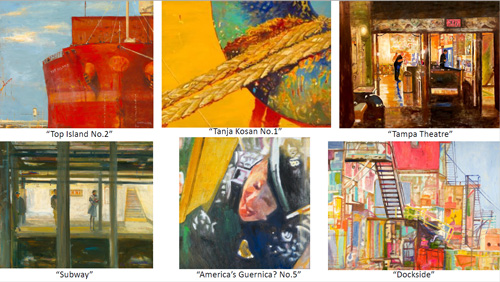Published by Waller & Wax Advisors, Inc.

1) When did you start painting and was there a defining moment when you decided to pursue your passion?
I have always loved art and art history. Art History classes at Tulane led to lifetime visits to art museums. While a financial planner, I would attend watercolor five-day workshops as a reprieve from the stresses of the stock market. Then, having been diagnosed with breast cancer in 2005, I began thinking about life after financial planning and transitioning the practice to Jon. You see, one of the gifts of cancer is that it gives permission to redesign your life. When I left the practice in 2012, I began intensive studies one on one with an oil painter whose work I admired. And as a Type A, I knew I’d need a schedule, workspace, and gallerists to work with. Maine has provided that.
2) How does your life experience affect your work? Are there any similarities to your time as a financial planner?
All art is autobiographical. I have always been an observer of ways of life and of people as reflected in the careers I’ve chosen—clinical social worker, financial planner, and artist. I also adore what I call “ Drop-Ins” — books, movies, and art that drop you into a new world you knew nothing about. That’s what fascinates me about Port Tampa Bay and the massive working ships that go in and out of our waterways. I realized what a vital part the port plays in our economy, our demographics and our jobs. Yet living here, I hardly noticed the port.
3) Your collections—Working Waterfront, Urban Landscapes and Urban interiors—highlight commercial shops, busy city streets, and subways. What do you see in these types of settings that drive your curiosity/inspiration? What do you hope viewers see from observing your paintings?
There is a Japanese concept called “Wabi Sabi” that I interpret to mean there is beauty in the ordinary. There is beauty all around us. If we can learn to see, really see, then the world opens up to us. The Ashcan Artists painted ordinary life and attracted a huge audience because I believe it felt familiar. If I can paint a gritty wall in the port covered with decades of rust and grime and make it almost appear as an abstract painting, then I am pleased.
4) How has your style changed over time?
Sometimes my work seems more abstract; sometimes more representational. I paint larger when doing the ships probably because they are massive and it is easier to portray that on a large canvas. Perhaps I’m using color more and I’m not afraid of exaggerating color for effect.
5) Describe your dream project.
A breakthrough for me in my art was when an instructor emphasized the need to paint what you see, not what you think you see. In some ways that could be said of gaslighting. What you see is your actual vision. Gaslighting in today’s world tries to tell you something other than what you saw. I painted a series called “America’s Guernica?”. I painted from television photos taken during the events of January 6th. Accurate paintings of the actual events. No gaslighting. What your eyes see.
6) What are you currently working on?
Working Waterfront paintings to be in a solo exhibition at Moss Galleries in Portland, Maine in late spring 2022.
7) Do you have any advice for someone that wants to start painting but doesn’t know where to start?
First of all, never say I can’t, I have no talent. Nonsense. Painting can and is taught. There are great workshops at the Tampa Museum of Art, Morean Center, Dunedin Fine Arts Center, Tampa Regional Artist Center etc. Here in Maine where I spend part of the year, Coastal Maine Art Workshops have great instructors.
Grab a sketchbook, a brush, a pen and a box of watercolors and sketch wherever you go. You’ll really see life around you.
8) Is there anything you would like to say to your former Waller & Wax clients?
Yes! I miss you and your families. As you get closer to your own retirement, develop other interests — whether it is art, philanthropy, tutoring, photography, whatever. It could give you a new life after retirement.
There are some old truisms that bear repeating:
Always live below your means.
Pay yourself first by saving a portion of any money that comes your way.
Retirement saving plans are sacred and for retirement.
And most important, keep you and your family safe during this pandemic.
All my best,
– Laura
